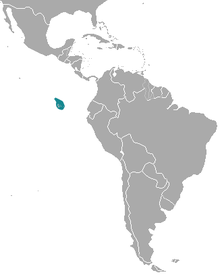Galápagos fur seal
| Galápagos fur seal | |
|---|---|
 |
|
| Male, Santiago Island | |
| Scientific classification | |
| Kingdom: | Animalia |
| Phylum: | Chordata |
| Class: | Mammalia |
| Order: | Carnivora |
| Suborder: | Pinnipedia |
| Family: | Otariidae |
| Subfamily: | |
| Genus: | |
| Species: | A. galapagoensis |
| Binomial name | |
|
Arctocephalus galapagoensis Heller, 1904 |
|
 |
|
| Galápagos fur seal range | |
The Galápagos fur seal (Arctocephalus galapagoensis) breeds on the Galápagos Islands in the eastern Pacific, west of mainland Ecuador.
Galápagos fur seals are the smallest of otariids. They have a grayish brown fur coat. The adult males of the species average 1.5 m (4 ft 11 in) in length and 64 kg (141 lb) in mass. The females average 1.2 m (3 ft 11 in) in length and 28 kg (62 lb) in mass. They spend more time out of the water than almost any other seal. On average, 70% of their time is spent on land. Most seal species spend 50% of their time on land and 50% in the water.
The Galápagos fur seal is endemic to the Galápagos Islands, with a single colony in northern Peru, according to the Organisation for Research and Conservation of Aquatic Animals; they live on the rocky shores of the islands, which tend to be on the west sides, leaving only to feed.
Galápagos fur seals live in large colonies on the rocky shores. These colonies are then divided into territories by the female seals during breeding season, which is mid-August to mid-November. Every mother seal claims a territory for herself and breeds her pup there.
Galápagos fur seals have the lowest reproductive rate reported in seals, and it takes an unusually long time to raise seal pups to independence. Females bear only one pup at a time, and she remains with her newborn for a week before leaving to feed. She then periodically returns to the pup and stays to suckle it for a few days before leaving on another hunting trip. Females recognize their own pups by smell and sound, and pups also learn to identify their mothers by the females’ “Pup Attraction Calls”. Mother-pup recognition is crucial because females exclusively nurse their own pups, often violently rejecting strange pups that approach. Orphaned seal pups usually try to sneak up on sleeping or calling females to suckle, but stealing milk is not enough to sustain the pups, and they usually die within a month.
Fur seal pups rely on their mother’s milk for the first eighteen months, and weaning may be delayed for up to two or three years if conditions are poor. The result is that every year up to 23% of pups are born when an older sibling is still suckling. Survival of the younger sibling greatly depends on the availability of resources. In years when there is abundant food, the mortality rate of second pups is as low as 5%, which is equivalent to the mortality rate of pups without siblings. In years when food is scarce, 80% of pups with suckling older siblings die within a month. The younger sibling thus serves as an insurance in case the first sibling dies, and also provides extra reproductive value in case conditions prove better than expected. Such a bet-hedging strategy is particularly useful in Galapagos fur seals, since there is a great deal of maternal investment in raising a seal pup to independence in an environment that has great fluctuations in food.
...
Wikipedia

